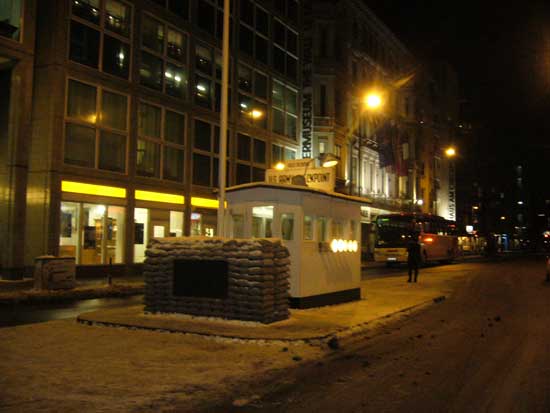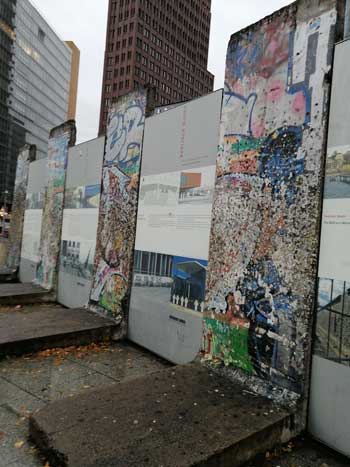The fall of the Wall and the dawn of unity
As I switched on the radio, I was pleasantly surprised to hear “Wind of Change,” a song I loved as a schoolgirl since it first aired on TV in the early 1990s. This iconic track by the German band Scorpions is renowned for its compelling blend of historical footage and the band’s emotive performance.
Hearing it again evoked vivid memories of the striking visuals, starting with the poignant scenes from Potsdamer Platz in Berlin in 1953, during the construction of the Berlin Wall in 1961 and ending in the area’s transformation in 1990. These scenes delivered a strong message of unity and hope, reflecting the monumental changes of that era.

Checkpoint Charlie: The official crossing point between East and West Berlin, now a museum
Released in the wake of the fall of the Berlin Wall in 1991, the song resonated profoundly with audiences worldwide, topping charts in many countries and continuing to be celebrated as a song of peace. It holds a special place in my heart, especially now as an alumna of Germany and regular visitor to Berlin, where the legacy of that time is still alive in the remnants of the Wall and the stories of resilience that it inspired.
In the aftermath of World War II, Germany found itself split in two, a nation torn between the Bundesrepublik Deutschland (Federal Republic of Germany/West Germany) and the Deutsche Demokratische Republik (German Democratic Republic/East Germany). This division marked the beginning of a complex and turbulent era.
On August 13, 1961, as waves of East Germans attempted to flee to West Berlin, the East German government acted quickly. Fearing an economic collapse and a loss of stability, they initiated the construction of a barrier that would come to define the city and symbolize a divided world—the Berlin Wall (Berliner Mauer).

Potsdamer Platz: Remnants of the Wall preserved
The initial set-up of barbed wire and barricades along the 43-kilometre (27-mile) boundary between the Eastern and Western sectors of Berlin quickly morphed into a much more imposing structure. Over the subsequent months and years, the initial temporary structures were replaced by a towering 3.6-metre (12-foot) concrete wall, which became a powerful emblem of division that would stand for nearly three decades.
The Wall was fortified with watchtowers that stood like sentinels of the terrain, alongside anti-vehicle trenches (designed to prevent any escape attempts) and a treacherous “death strip”. This turned into a “No-Man’s Land” marked by landmines, patrolled by guard dogs and covered in sand to identify the tracks of those courageous enough to attempt a crossing.
To compound the situation, a second fence, referred to as the “Hinterlandmauer” (inner wall), was constructed later.
For 28 long years, the Berlin Wall, which extended roughly 155 km (96 miles), stood as a formidable division, separating not just a city but also the very spirit of a nation. Then, on a historic day, November 9, 1989, the atmosphere was charged with transformation. East German authorities, likely responding to the growing demand for liberty, made an unexpected announcement: citizens were allowed to cross the border freely!
The news spread rapidly, sparking a wave of joy among the people on both sides of the Wall. Residents of East and West Berlin rushed to the barrier participating in a spontaneous celebration of solidarity as they began to dismantle the concrete structure that divided not only their city but also the whole nation. The rhythmic sound of hammers striking stone resonated, laughter echoed, and tears of happiness blended with expressions of astonishment.
With the Wall’s fall, Berlin initiated its journey towards reunification, and in 1990, it was declared the capital of a newly unified Germany. Once a symbol of division, the city emerged as an inspiration of hope and unity, embracing its diverse history while looking forward to a future where barriers were transformed into bridges, and the spirit of resilience flourished in every corner of its streets.
Today, the remnants of the Berlin Wall serve as significant historical monuments symbolizing the division that once split not only Germany but the entire world. While a large portion of the Wall was dismantled following the reunification, several sections and fragments have been preserved as cherished landmarks. The remnants have been converted into memorials and artistic works. The most notable sites where one can find the remnants of the Berlin Wall include;
East Side Gallery: this vibrant stretch of the Wall (1316 metres) is embellished with artwork painted by artists from various countries, representing themes of freedom and unity. It is the largest open-air gallery in the world.
Berlin Wall Memorial (Gedenkstätte Berliner Mauer): Here, visitors can explore the preserved portion of the Wall, with information centres that narrate the historical background of the Wall.
Checkpoint Charlie: Once recognized as the most famous border crossing point between East and West Berlin, this site has transformed into a museum.
Potsdamer Platz: Once a bustling centre of activity in Berlin, this area experienced profound transformation due to the construction of the Wall. Today, it stands as a symbol of Berlin’s restoration and reunification efforts.
The fall of the Berlin Wall was not merely the elimination of a physical divide; it marked a pivotal moment that reshaped Germany’s identity and initiated substantial changes across Europe and beyond. The disintegration of the Wall in November 1989 signified the end of a prolonged period of separation, affecting various aspects such as culture, sports, and scientific advancements.
As the barriers were dismantled, a nation that had been split for decades began to reconnect, igniting a powerful spirit of collaboration. Artists, musicians, and philosophers from both East and West, converged to share their thoughts, sparking a cultural renaissance. In parallel, sports teams unified and harnessed their collective abilities, which led to significant accomplishments on the international stage. In the realms of science and technology, researchers and institutions that had once been isolated from each other began to collaborate and exchange knowledge and resources. This cooperation spurred innovation that positioned Germany as a frontrunner in multiple disciplines.
The transformation of Germany highlights the powerful influence of unity and teamwork. The remnants of the Berlin Wall, once a symbol of division, now stand as a testament to the strength derived from togetherness – a compelling reminder for those who believe in the idea of collective effort in building a better tomorrow. And each time I wander the streets of Berlin, I find myself thinking of a verse from a renowned Sinhalese patriotic song that embodies the spirit of unity and strength – “nagi sitiya haka eksath wee” ….
( The writer is attached to the University of Ruhuna)
Searching for an ideal partner? Find your soul mate on Hitad.lk, Sri Lanka's favourite marriage proposals page. With Hitad.lk matrimonial advertisements you have access to thousands of ads from potential suitors who are looking for someone just like you.


